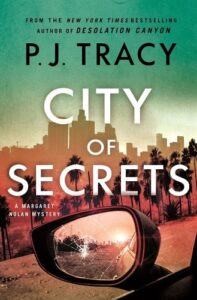What do Minneapolis and Los Angeles have in common?
Not much.
I don’t mean that in a perjorative way. Different isn’t bad, it’s just…well, different. The zeitgeist, intensity level, culture, and lifestyle are about as bipolar as you can get. Minnesota is tribal and deeply rooted in stoic, northern European traditions, largely homogenous and humble. Strangers will not only help you, they’ll buy you a coffee afterwards. You might even become good friends, at least until you’re invited for Christmas dinner and they’re serving lutefisk. Do not go there.
Conversely, Los Angeles is a big, blowsy, lovable drama queen and a diverse city of transplants, human and botanical (the iconic palm trees are not native.) Dreams are outsized there, and the higher you aim, the farther you fall if those dreams don’t come to fruition. The city can be paradise on earth or a scuzzy, last-chance motel as wretched as the ones in Leaving Las Vegas. There are two different LAs, and neither one will buy you a coffee, but who cares? It’s a magical place and kindness from strangers is the last thing on your mind once you’re bewitched.
Both cities have abundant charms and which one you prefer depends on your mood. I love a smooth jazz track, but I also crave punk rock. Give me an honest, hard-working bar of chocolate with no pretense that it will be anything other than what it advertises, and I will find inner peace. But those gold-dusted bon bons with mystery filling plumb an entirely different part of the brain that has nothing to do with serenity and everything to do with sheer exhilaration.
I was thinking about this recently in preparation for the launch of CITY OF SECRETS, the fourth in Detective Margaret Nolan’s modern noir series set in gritty, glittery LA. How did a Minnesota girl who wrote ten Midwestern-based Monkeewrench novels (soon to be eleven) end up writing about Maggie’s life in the other, and by no means lesser, city of sin?
Because I’ve been fortunate enough to have lived for extended periods in both places. It’s embedded in a writer’s DNA to be a sponge, soaking up experiences and observations to exploit later, and it’s a dream to become fully immersed in two divergent cultures. Not only does it flip your perspective bum over teakettle, it doubles the creative fodder you can draw from, allowing you to type your fingers off with authority and authenticity. ‘Write what you know’ isn’t a hackneyed chestnut, it’s wisdom.
I serve the characters in each series as a parent does their children (they’re constantly needy), and like a real human family, they require different treatment. It’s surprisingly easy to shift between the two worlds, and ironically, I wrote most of the Monkeewrench novels while living in LA, and all of the Maggie Nolan novels while living in Minnesota. Once a place gets in your blood, you can access it anywhere, anytime.
I’ve been talking about the differences between the two cities, but there is a striking and predictable similarity – crime. Specifically murder. It’s always existed and it’s the same everywhere; a universal constant wherever there are human beings. There are no new motives under the sun. And no new methods, at least that I can’t think of, and I spend way too much time trying to come up with creative ways to kill people.
The evolution of technology has improved the tools, of course, but a nuclear bomb is still a bomb; nerve gas still a poison. Rudimentary or high-tech, a knife is a knife and a gun is a gun. People have been getting burned, bludgeoned, run over, and pushed off cliffs or out windows since biblical times. (I brought up windows because I adore the word defenestration, and it’s not something you can effortlessly incorporate into cocktail party banter.)
Murder is a base, prosaic act at its core, and I don’t write about it because I find it interesting. What drives my work is an obsession with the sweeping effects it has on people; the tragedy of the aftermath, which has also been the same since time immemorial. A single murder is a nightmare that resonates like a shockwave and knocks down everyone in the sphere of the victim’s life, including the people whose job it is to deliver justice. I want to know how Maggie and her partner Al cope with seeing the darkest, most depraved aspects of the human psyche on a daily basis without losing their minds.
I’m a Sturm un Drang girl at heart. Sturm un Drang (storm and stress) was an 18th century German movement where writers, artists, and composers rejected the fluffier norms of Neoclassicism to focus on the extremes of human experience and individual emotional reactions. Embracing this philosophy as a writer wasn’t a conscious decision but an organic process. When you don’t understand something, you’re bound to work it out on paper, and I can’t understand complete disregard for human life. Anyone who can is not a person you want as a neighbor. Yet killers hide in plain sight in various guises and they’re all somebody’s neighbor.
Excuse me while I go lock my door…
But I have some good news. Murder is statistically rare and most people are good. Wherever we live or whatever our background, we law-abiding citizens who understand that community is necessary for survival have enduring commonalities that bind us all. We want to love and be loved; we want a safe home and happiness; we want to be productive and contribute to our families and friends and society. Our hopes and dreams transcend our differences.
Light and dark, good and evil, have always co-existed, and getting to know Maggie and Al over four books has taught me that like every living thing, they seek the light and don’t let the shadows of their job eclipse the joy of sun on their faces. They’re eternal optimists because I am, and that’s one of the most valuable human traits because it enables you to survive anything.
I hope you enjoy reading CITY OF SECRETS as much as I enjoyed writing it. And I really meant it when I told you not to accept a dinner invitation when lutefisk is on the menu. My apologies to anyone I might be offending – if you love it, you have my respect.
***


















